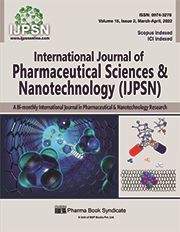A Novel Analytical Method for the Determination of Residual Solvents in Mesalamine Delayed Release Tablets by GC-HS Method
DOI:
https://doi.org/10.37285/ijpsn.2022.15.3.5Abstract
Background: Residual solvents and organic volatile impurities are monitored using Head Space Gas Chromatography present in pharmaceutical samples. Mesalamine is a 5-aminosalicylic acid 5-ASA based agent which is used to treat adults with ulcerative colitis.
Objective: In this study, an attempt was made to analyze the residual organic solvents such as isopropyl alcohol and dichloromethane present in Mesalamine Delayed-Release Tablets by headspace gas chromatography (HS-GC).
Method: The carrier gas streamed was nitrogen, the method was developed and optimized by using a DB-624(60 m × 0.53 mm × 3.0 µm) column coupled with a flame ionization detector. A capillary column consisting of 6 % cyanopropylphenyl - 94 % dimethyl polysiloxane was employed as the stationary phase. An injector temperature of 200°C was programmed to prevent degradation.
Results: A temperature of 40°C was set as the initial oven temperature for a period of 10 min and set at a rate of 20°C min−1 and monitored at a final temperature of 220°C for 5 min. Chloroform and N, N-dimethylacetamide was selected as the sample solvent. The validation studies were performed with regard to International Council for Harmonization (ICH) Q2 guidelines for the validation of analytical experiments.
Conclusion: All the validation parameters complied with the acceptance criteria. Hence, the optimized method developed and validated can be utilized for the concurrent estimation of residual solvents in tablet formulations.
Downloads
Metrics
Keywords:
GC-HS, Isopropyl Alcohol, Dichloromethane, Residual Solvents, Mesalamine Delayed Release TabletsDownloads
Published
How to Cite
Issue
Section
References
Feng, Xiao-Zhen, Guo-Cheng Han, Jianhe Qin, Shi-Min Yin, and Zhencheng Chen. 2016. “Determination of Residual Solvents in Linezolid by Static Headspace GC.” Journal of Chromatographic Science 54 (4): 487–91. https://doi.org/10.1093/chromsci/bmv175.
Jeličić, Mario-Livio, Edvin Brusač, Daniela Amidžić Klarić, Biljana Nigović, Nikša Turk, and Ana Mornar. 2020. “A Chromatographic Approach to Development of 5-Aminosalicylate/Folic Acid Fixed-Dose Combinations for Treatment of Crohn’s Disease and Ulcerative Colitis.” Scientific Reports 10 (1): 20838. https://doi.org/10.1038/s41598-020-77654-2.
Kanubhai, Trivedi Rakshit, Patel Mukesh C, and Kharkar Amit R. 2011. “Determination of Mesalamine Related Impurities from Drug Product by Reversed Phase Validated UPLC Method.” E-Journal of Chemistry 8: 382137. https://doi.org/10.1155/2011/382137.
Karagozian, Raffi, and Robert Burakoff. 2007. “The Role of Mesalamine in the Treatment of Ulcerative Colitis.” Therapeutics and Clinical Risk Management 3 (5): 893–903. https://doi.org/10.24292/01.mf.0321.7.
Noorbasha, Khaleel, and Abdul Rahaman Shaik. 2021. “Determination of Residual Solvents in Paclitaxel by Headspace Gas Chromatography.” Future Journal of Pharmaceutical Sciences 7 (1): 40. https://doi.org/10.1186/s43094-021-00186-7.
Patel, Km, Cn Patel, B Panigrahi, As Parikh, and Hn Patel. 2010. “Development and Validation of Spectrophotometric Methods for the Estimation of Mesalamine in Tablet Dosage Forms.” Journal of Young Pharmacists : JYP 2 (3): 284–88. https://doi.org/10.4103/0975-1483.66789.
Pilaniya, Kavita, Harish K Chandrawanshi, Urmila Pilaniya, Pooja Manchandani, Pratishtha Jain, and Nitin Singh. 2010. “Recent Trends in the Impurity Profile of Pharmaceuticals.” Journal of Advanced Pharmaceutical Technology & Research 1 (3): 302–10. https://doi.org/10.4103/0110-5558.72422.
Sahoo, Nalini Kanta, Madhusmita Sahu, Podilapu Srinivasa Rao, and Goutam Ghosh. 2013. “Validation of Stability Indicating RP-HPLC Method for the Estimation of Mesalamine in Bulk and Tablet Dosage Form.” Pharmaceutical Methods 4 (2): 56–61. https://doi.org/https://doi.org/10.1016/j.phme.2013.12.003.
Siddiqui, Masoom Raza, Zeid A AlOthman, and Nafisur Rahman. 2017. “Analytical Techniques in Pharmaceutical Analysis: A Review.” Arabian Journal of Chemistry 10: S1409–21. https://doi.org/https://doi.org/10.1016/j.arabjc.2013.04.016.
Trivedi, Rakshit Kanubhai, and Mukesh C Patel. 2011. “Evaluation of Pharmaceutical Quality of Mesalamine Delayed Release Tablets Using a New High Sensitivity Reversed-Phase UPLC Method for Its Genotoxic/Aniline Impurity.” E-Journal of Chemistry 8: 953235. https://doi.org/10.1155/2011/953235.
Wang, Yuwen, John McCaffrey, and Daniel L Norwood. 2008. “Recent Advances in Headspace Gas Chromatography.” Journal of Liquid Chromatography & Related Technologies 31 (11–12): 1823–51. https://doi.org/10.1080/10826070802129092.
Zaid, Abdel Naser. 2020. “A Comprehensive Review on Pharmaceutical Film Coating: Past, Present, and Future.” Drug Design, Development and Therapy 14: 4613–23. https://doi.org/10.2147/DDDT.S277439.






